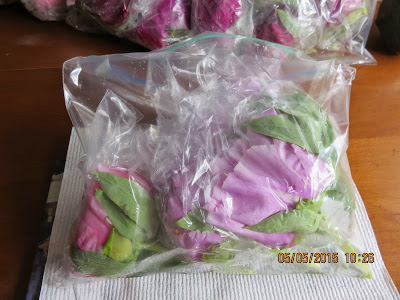In some respects, it's hard to believe that the last post was on March 26 of this year. Where did April go? Where, in fact, did spring go? We're still in the first half of May, and we have already had daytime temperatures in the 90s F. We shivered through most of April, and when the garden woke up, there was such a surge of growth that there was no keeping up with it. This has been the kind of year which makes me wonder if my gardening hobby has gotten so big that it's out of hand, if maybe it's time to begin cutting back. For instance, during the first two weeks of May I cut about 120 tree peony buds; they're in the refrigerator now. The ones I did not cut lasted about two days and are now heaps of petals shriveling on the ground. Past experience suggests that the ones in the refrigerator will last about two weeks. But there are so many other things stealing my attention: when will I have time to enjoy the tree peonies?
If you want to try to save your own tree peony buds in the refrigerator, these will show you how I do it. The system of double bagging the buds and blooms makes it simple to handle these otherwise very fragile blossoms.
The image below shows a single bud/bloom in a sandwich bag: poke a hole in a corner of the bag, insert the stem of the bloom through the hole, and carefully draw the bag up over the bud/bloom..
Below you see four buds packed into a gallon sized bag. After you have placed several in a gallon sized bag, add water to the gallon sized bag and be sure the stems poking out of the sandwich bags are in the water.
Here's a group of about thirty buds about to be moved to the refrigerator:
These bags of four make nice gifts to flower loving friends. Few people have ever had tree peony flowers, and even people who know them are often amazed at how magnificently these stored bloom expand when brought out into the light and warmth of a room.
In the image at the top of this post is a tree peony obtained without a label. I don't like the imprecision of poor labels, so I hesitated to show this image. From the earliest days of imported tree peony plants, two of the most commonly cultivated "varieties" are "tree peony without a label" and "tree peony which does not match its label". But a rose by any other name...




No comments:
Post a Comment